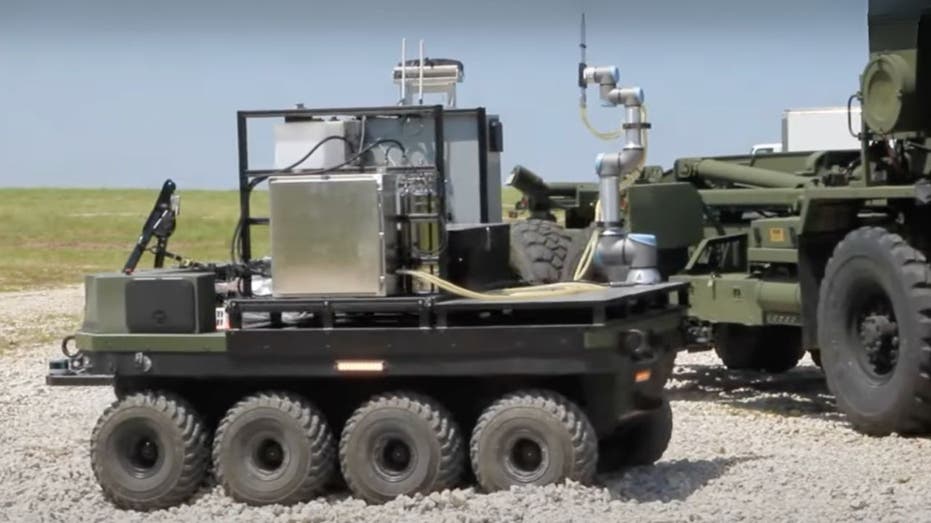The military robot protecting soldiers from chemical, biological dangers
The Army has developed a robot to protect soldiers against nuclear, biological and chemical weapons to make the battlefield safer for men and women in uniform.

Have you ever wondered how our brave soldiers deal with nasty stuff like chemical and biological weapons? Currently, it's a risky and time-consuming process. Soldiers have to suit up in cumbersome NBC (nuclear, biological, chemical) protective gear and spend about an hour decontaminating a single vehicle. It's not just uncomfortable, it's downright dangerous, putting our troops directly in harm's way.
However, that's all about to change because the Army is rolling out some seriously cool robot tech that's about to change the game. So, instead of soldiers suiting up in those bulky hazmat suits to clean contaminated vehicles, they’ve got smart robots doing the dirty work.
This new system, called the autonomous equipment decontamination system, is all about keeping our troops safe. Let's look into how this new technology is revolutionizing military operations and making the battlefield a whole lot safer for our men and women in uniform.
GET SECURITY ALERTS AND EXPERT TIPS - SIGN UP FOR KURT’S NEWSLETTER - THE CYBERGUY REPORT HERE
Nuclear, chemical and biological (NBC) weapons have long been a source of fear and deterrence in global conflicts. While their use has been limited since World War I, the potential for deployment by rogue states or in near-peer conflicts remains a constant concern. Countries like Iraq and Syria have demonstrated that these weapons still exist and can be used, prompting NATO and other military organizations to conduct regular anti-NBC drills to prepare for potential threats.
NEW BREED OF MILITARY AI ROBO-DOGS COULD BE THE MARINES' SECRET WEAPON
Decontaminating vehicles and equipment exposed to chemical or biological agents is a daunting task that poses significant challenges. The process is not only time-consuming but also extremely dangerous for the soldiers involved. It can take up to an hour and require the efforts of 30 soldiers, all of whom must wear cumbersome NBC suits designed to protect them from exposure. These suits, while theoretically capable of being worn for extended periods, can be uncomfortable and restrictive, making the decontamination process even more arduous.
THIS IS THE WAY CLEAN FREAKS GET THEIR FILTHY TECH SPOTLESS
COULD THESE CREEPY, DEAD, STUFFED BIRDS BE USED AS DRONES FOR THE MILITARY?
To address these challenges, the Army is developing the autonomous equipment decontamination system. This innovative robotic system utilizes cameras and a mobile platform to identify contaminated areas and clean them without putting soldiers at risk. By taking on the dangerous task of decontamination, the system promises to enhance safety for military personnel in the field.
HOW TO STOP ANNOYING ROBOCALLS
U.S. MILITARY JET FLOWN BY AI FOR 17 HOURS: SHOULD YOU BE WORRIED
The autonomous equipment decontamination system employs a camera-equipped unmanned ground vehicle that scans the contaminated vehicle's surface. As it circles the vehicle, the camera transmits contamination data back to operators who are safely positioned at a computer. A robotic arm then uses this data to apply a special cleaning solution to the identified hot spots. This approach not only protects soldiers from hazardous exposure but also conserves valuable decontaminants, which are often in limited supply during military operations.
At a recent testing event called MSPIX (Maneuver Support and Protection Integration eXperiments), soldiers from the 1st Armored Division had the opportunity to operate the system and provide crucial feedback. Their insights will play an important role in refining the technology and ensuring it meets the needs of those on the front lines.
WHAT IS ARTIFICIAL INTELLIGENCE (AI)?
The soldiers expressed their enthusiasm about the system, emphasizing that it allows them to remain safe while effectively managing decontamination tasks. They appreciated the user-friendly interface and the opportunity to communicate directly with the technology developers, ensuring that their requirements were taken into account.
The autonomous equipment decontamination system offers several significant advantages. By keeping soldiers away from dangerous contaminants, it reduces the risk to human life during decontamination operations. Additionally, the system minimizes the time and soldiers required for these tasks, allowing military personnel to focus on their primary missions. Furthermore, by conserving water and decontaminant resources, the system enhances operational efficiency. What's more, the ability to operate the system from a safe distance ensures that soldiers can maintain their safety while effectively managing potential threats.
GET FOX BUSINESS ON THE GO BY CLICKING HERE
The development of the autonomous equipment decontamination system is a game-changer when it comes to keeping our soldiers safe from the dangers posed by chemical and biological weapons. By harnessing the power of robotics and autonomous technology, the military is not only reducing the risks to human life but also making decontamination procedures much more efficient. As this technology advances, it’s becoming an essential tool in modern warfare. It allows our military personnel to operate safely and effectively, even in hazardous environments.
In a world where the threat of nuclear, chemical and biological weapons is still very real, innovations like this are vital for ensuring the safety and effectiveness of our armed forces. It’s reassuring to think about how these advancements can help protect those who serve and keep them out of harm's way.
How do you feel about the impact of technology on soldier safety? Do you think robotic systems are the future of military operations? Let us know by writing us at Cyberguy.com/Contact.
For more of my tech tips and security alerts, subscribe to my free CyberGuy Report Newsletter by heading to Cyberguy.com/Newsletter.
Ask Kurt a question or let us know what stories you'd like us to cover.
Follow Kurt on his social channels:
Answers to the most asked CyberGuy questions:
New from Kurt:
Copyright 2024 CyberGuy.com. All rights reserved.



